Ventilated Cavity CFD Simulation by ANSYS Fluent Training
Free
- The problem numerically simulates the airflow over a ventilated air cavity using ANSYS Fluent software.
- We design the 3-D model by the Design Modeler software.
- We mesh the model with ANSYS Meshing software, and the element number equals 803616.
- We aim to study Drag force in this project.
To Order Your Project or benefit from a CFD consultation, contact our experts via email (info@mr-cfd.com), online support tab, or WhatsApp at +44 7443 197273.
There are some Free Products to check our service quality.
If you want the training video in another language instead of English, ask it via info@mr-cfd.com after you buy the product.
Description
Description
In this project, the steady airflow over a ventilated air cavity is investigated using ANSYS Fluent software. We perform this CFD project and investigate it by CFD analysis.
The three-dimensional geometry of this project has been produced with Design modeler software and consists of a cavity placed within a rectangular domain.
The meshing of this project has been done with ANSYS Meshing software, and the total number of elements is 803616.
Ventilated Cavity Methodology
In this project, steady airflow over a ventilated air cavity is investigated by ANSYS Fluent software. The simulated cavity has a hole extending in the flow direction all over the cavity length, making the simulation more challenging.
Fluid flow over objects is important since the results are useful in several branches of fluid mechanics, such as aerodynamics. A built-in hole in the cavity geometry enables flow penetration inside the cavity.
It reduces the pressure drop upstream and downstream of the cavity, which decreases the drag force exerted on the cavity by the airflow.
Airflow velocity at the inlet boundary condition is equal to 1.7 m/s. Due to high flow velocity, the K-epsilon turbulence model is chosen for solving fluid flow domain equations.
Ventilated Cavity Conclusion
At the end of the solution process, two-dimensional contours related to pressure, velocity, and streamlines are obtained. As can be seen, the maximum velocity captured in the domain is equal to 2.32 m/s which occurs on the leading edge of the cavity.
Also, using the data extracted from the Fluent, the air mass flow rate at the outlet is equal to 6.747232 kg/s. The drag force for the cube is equal to 0.0001168629 N.
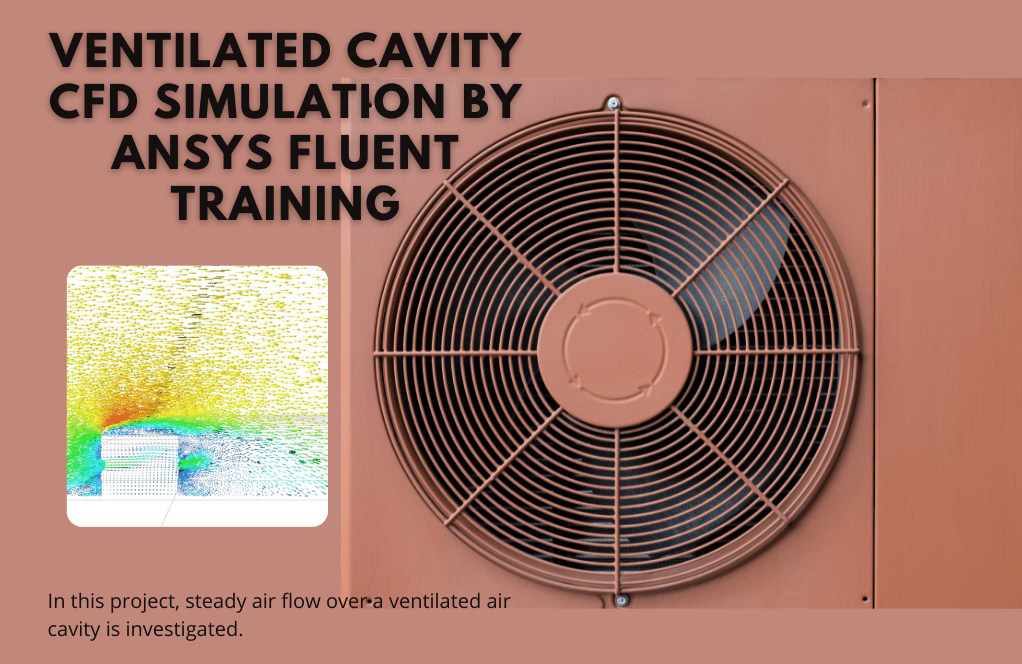
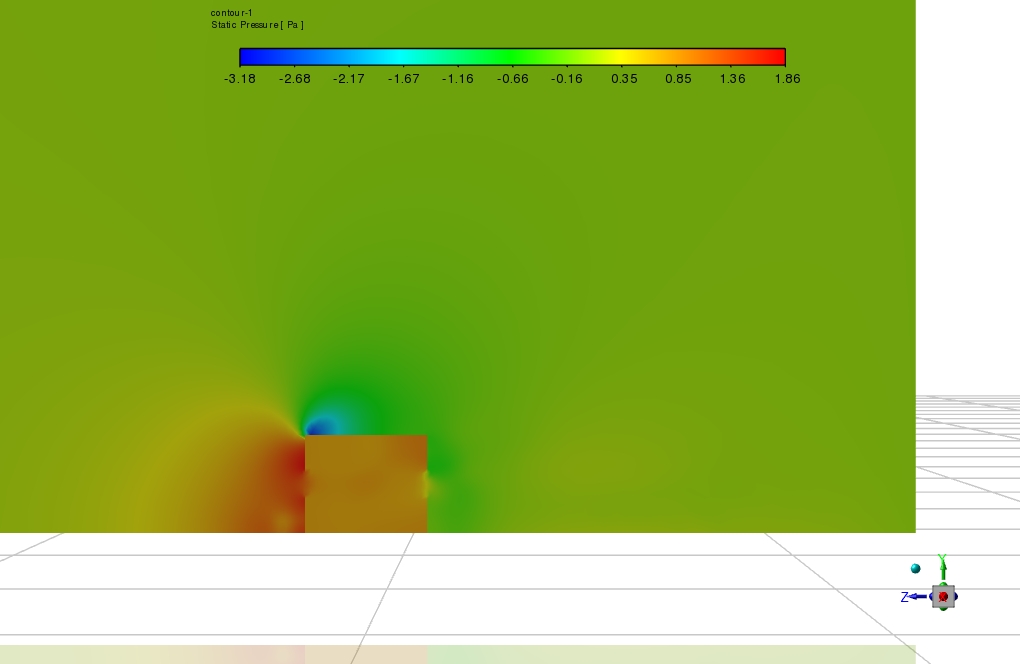
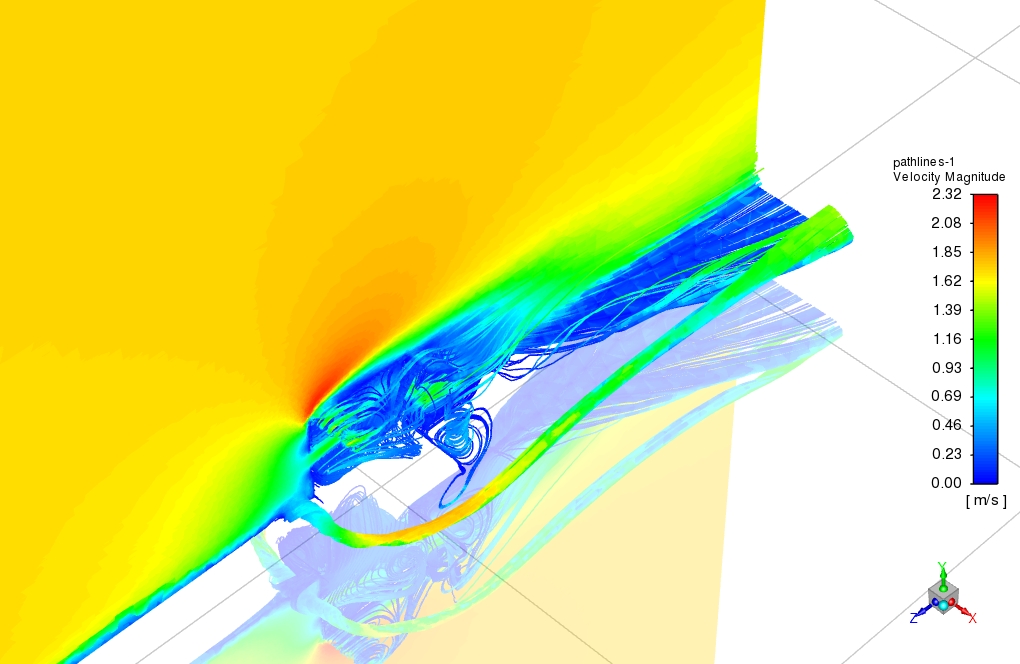
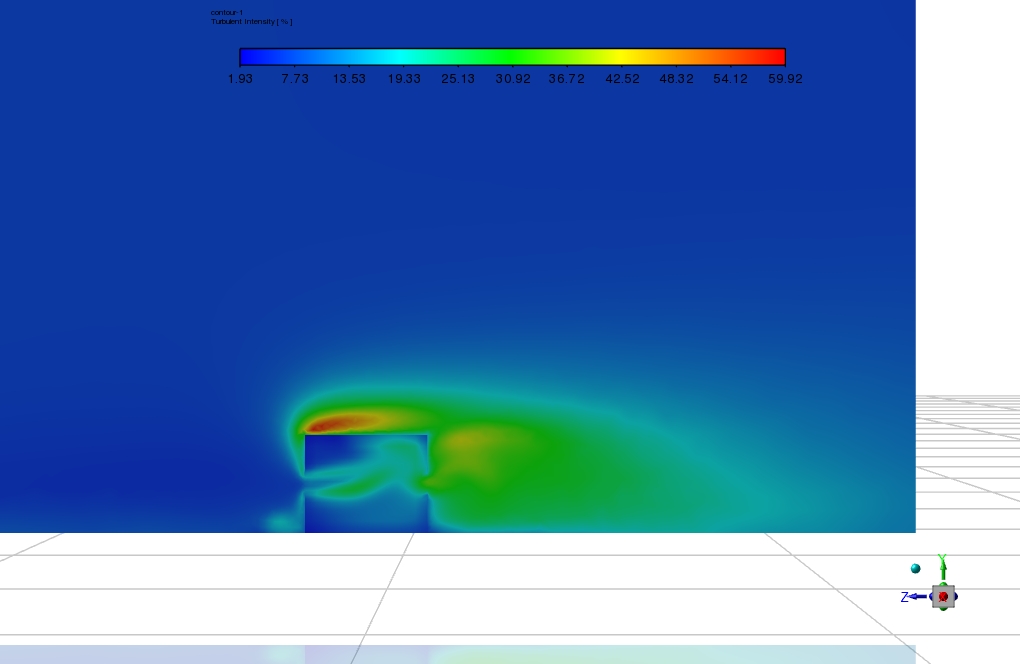
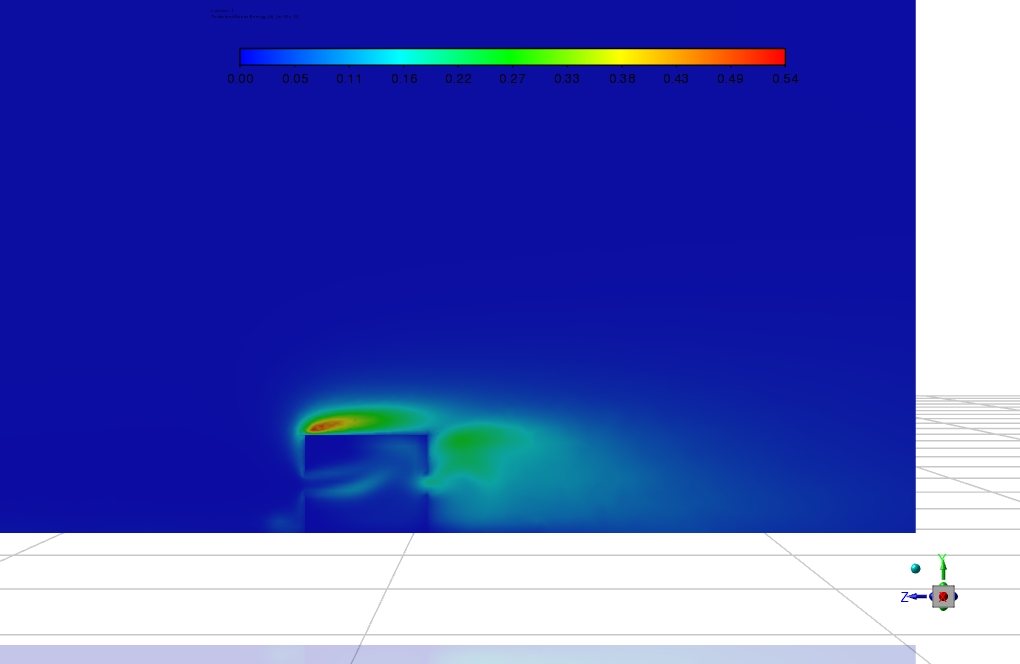
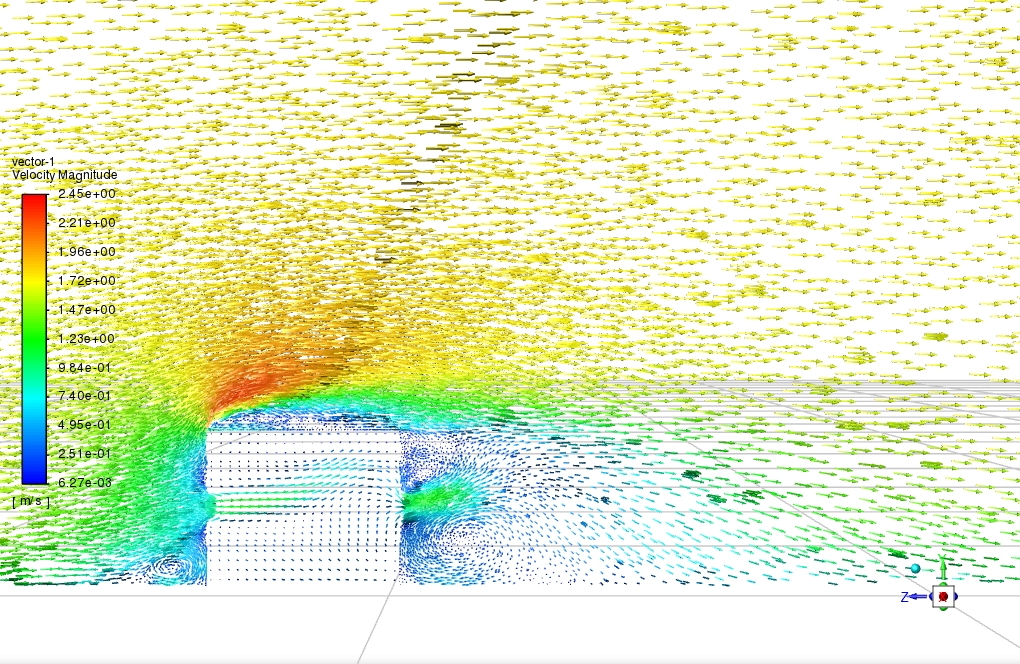
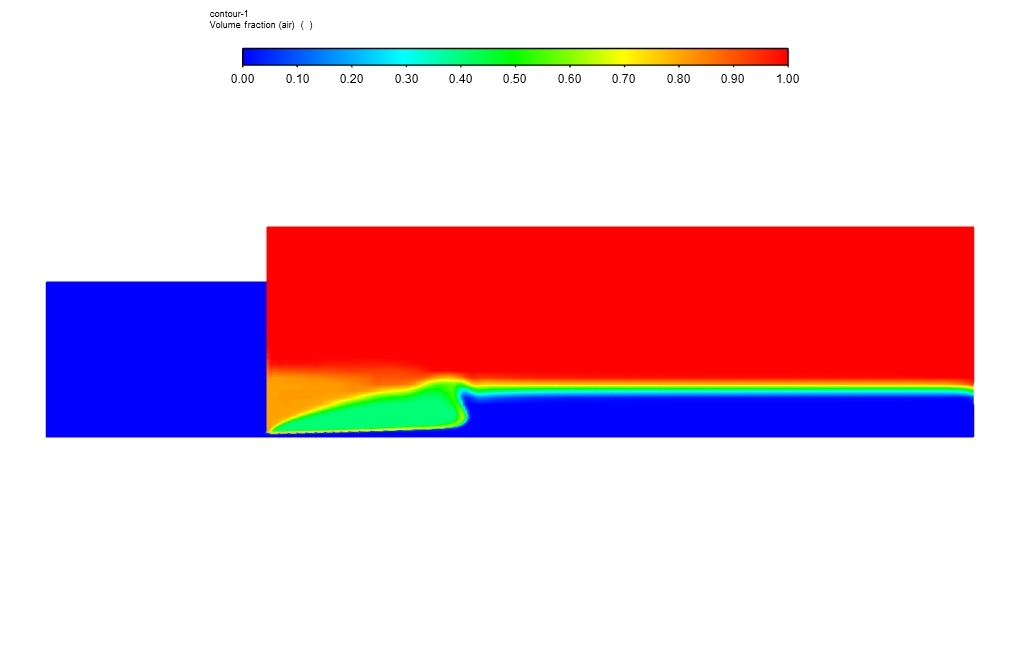
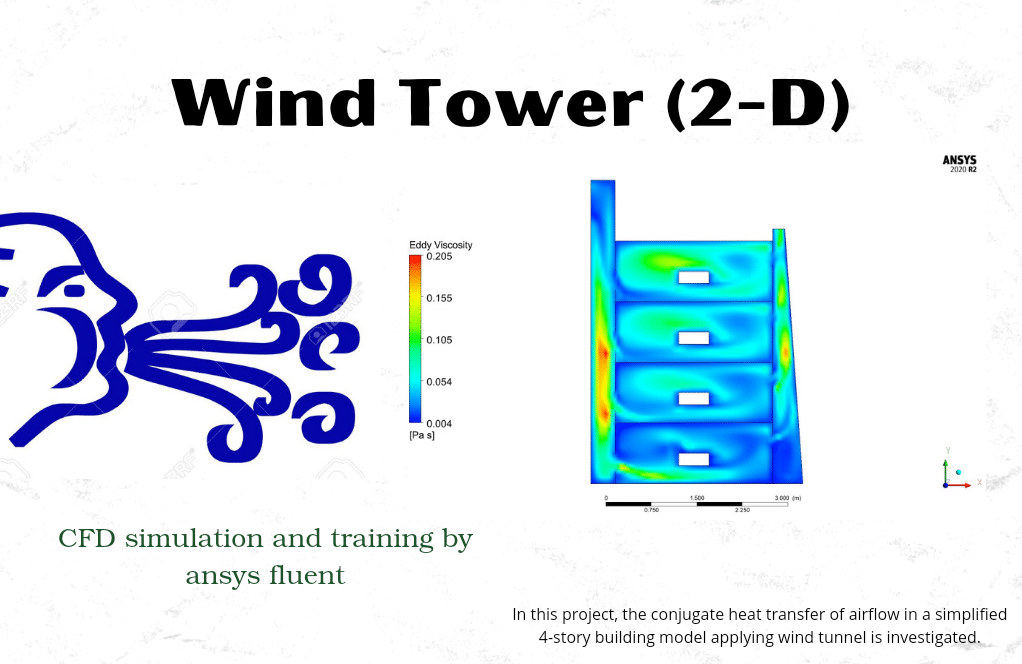

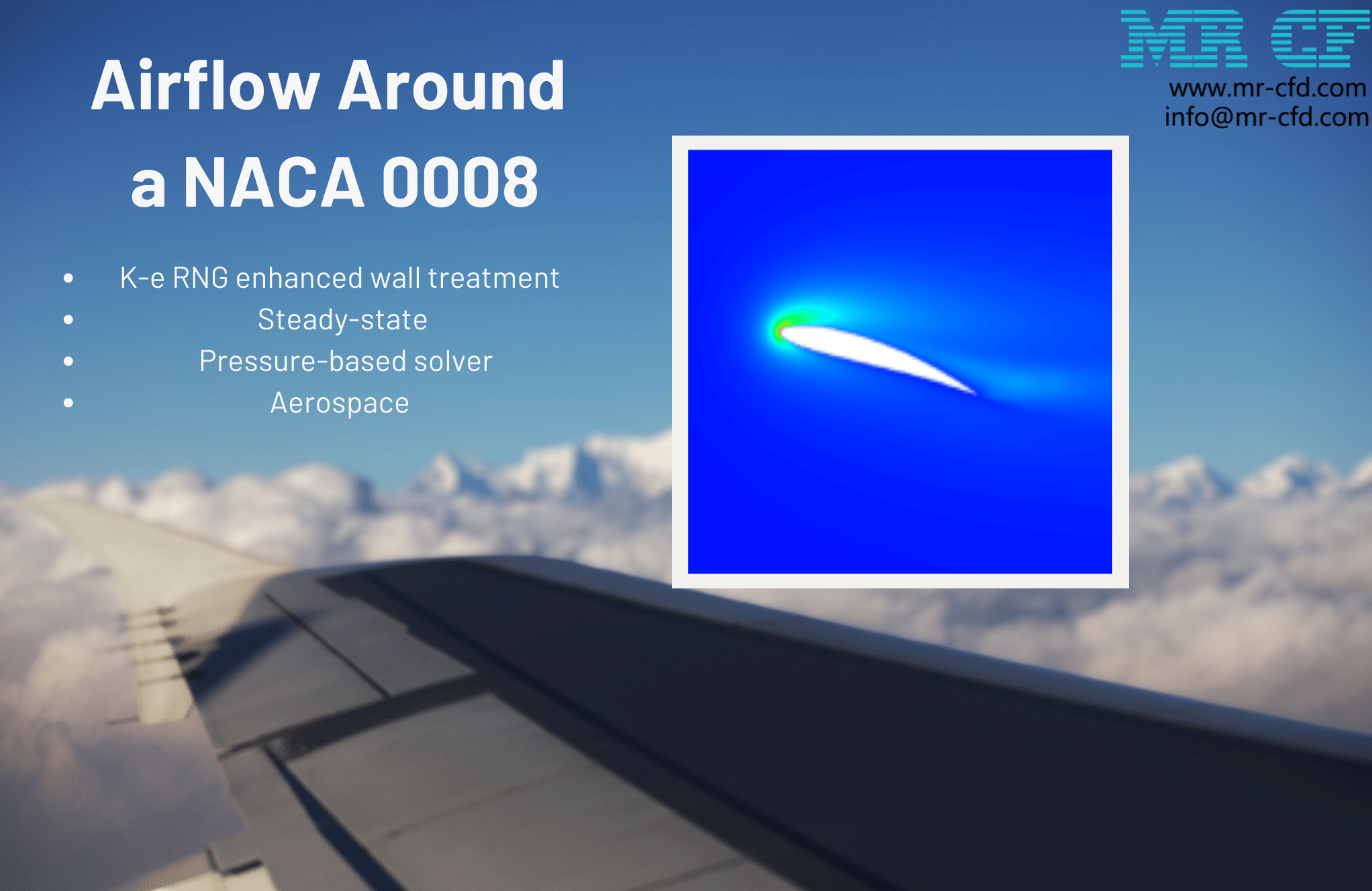
Halle Swaniawski –
Can the simulation be used to analyze the transient behavior of the air flow within the ventilated air cavity?
MR CFD Support –
Yes, the simulation can be run in either steady-state or transient mode. This allows it to capture the dynamic behavior of the air flow within the ventilated air cavity.
Prof. Jamal Rippin Sr. –
The results are absolutely fascinating! The attention to detail in the setup has provided a comprehensive understanding of ventilated cavity airflow. The drag force calculation only solidifies the usefulness of this simulation in aerodynamic studies.
MR CFD Support –
Thank you for your kind words! We’re thrilled that you found the CFD simulation both fascinating and useful. It’s rewarding to know our attention to detail is appreciated and aids in understanding complex airflow dynamics. Your recognition of the application in aerodynamic studies is much valued!
Mittie Stamm –
I found the training on ventilated cavity CFD remarkably comprehensive. The progression from geometry creation to meshing and the detailed insight into airflow dynamics is quite beneficial for understanding the complexities involved in such simulations.
MR CFD Support –
Thank you for your positive feedback! We’re thrilled to hear that you found our training comprehensive and insightful. It’s great to know that our efforts to provide an in-depth understanding of CFD simulations are beneficial to our customers.
Fatima Bechtelar –
How can I get started with using this simulation?
MR CFD Support –
You can purchase this simulation directly from our website. After purchase, you’ll receive a download link along with detailed instructions on how to set up and run the simulation.
Marshall DuBuque –
The step-by-step process was so clear and easy to follow! Thanks to this training, I’ve got a solid understanding of ventilated cavity simulations.
MR CFD Support –
We’re delighted to hear that our training materials were helpful to you. Your positive feedback means a lot to us. Thank you for taking the time to let us know!
Dr. Eloy Kutch Sr. –
I’m very pleased with the Ventilated Cavity CFD Simulation training using ANSYS Fluent. The methodology covered in this course allowed me to understand the important principles of aerodynamics when dealing with ventilated situations. The detailed insights into setting up such a simulation, from the creation of the geometry to the analysis of results, have been incredibly informative. The inclusion of turbulence modeling and its impact on results were particularly beneficial. I especially appreciated seeing the practical outcome of this training, like learning about the drag force calculations and air mass flow rate measurements. The training was well-structured, which made complex topics easier to grasp. Kudos to MR CFD Company for providing such a comprehensive learning experience!
MR CFD Support –
Thank you for your kind words! We are thrilled to hear that you found the Ventilated Cavity CFD Simulation training valuable and that it has helped you grasp the complex aerodynamic principles. Your feedback is greatly appreciated and helps us continue to deliver quality education. If you have any further insights or need additional assistance, please do not hesitate to reach out.
Karli Rath –
I’m impressed with the depth of the study on the ventilated cavity, and I found the explanation of the methodology very enlightening. The focus on the airflow dynamics and especially the inclusion of a built-in hole in the geometry that enables flow penetration shows an innovative approach. Great results showcasing the max velocity and drag force. Really useful for those interested in aerodynamics or similar fields!
MR CFD Support –
Thank you for your kind words and appreciation of our Ventilated Cavity CFD Simulation training material. We always strive to provide detailed analyses and innovative approaches in our projects. It’s rewarding to hear that the explanation of our methodologies proved informative for you. We look forward to offering continued value in your studies and research related to fluid dynamics!
Emilie Grady –
Just finished the Ventilated Cavity CFD course – I’m quite impressed with the level of detail in the explanations. The contours and calculations really help understand the impact of ventilation on flow dynamics!
MR CFD Support –
Thank you for your positive feedback! We’re delighted to hear that our training on Ventilated Cavity CFD Simulation was informative and helpful. Understanding the dynamics of airflow is crucial for many applications, and we aim to provide clear and detailed insights for our users. If you have any further questions or need more information on CFD simulations, feel free to reach out!
Kellen Boyer –
I’m impressed with the level of detail in the Ventilated Cavity CFD Simulation project. The K-epsilon turbulence model seems particularly well-suited for the high-velocity conditions described. Is this turbulence model generally the best choice for these types of aerodynamic simulations in practice settings?
MR CFD Support –
We appreciate your compliments on our Ventilated Cavity CFD Simulation training. Indeed, the K-epsilon turbulence model is widely used for high-velocity and fully turbulent flow conditions thanks to its accuracy and reliability in predicting the average flow field characteristics. However, for simulations where accurate wall-bounded flows or areas close to the wall are of interest, or for flows with significant curvature, rotation, or where adverse pressure gradients are present, more advanced turbulence models, like the SST k-omega or LES models, might be required. It is always advisable to consider the specifics of each case when choosing the most suitable turbulence model.
Ila Wunsch –
I just finished the Ventilated Cavity CFD Simulation by ANSYS Fluent training, and I must say, I’m thoroughly impressed. The depth and clarity of the training content made learning complex theories much more approachable. The project explored the specifics of airflow over a ventilated air cavity so effectively, I was able to fully grasp the intricate dynamics involved. Kudos to the MR CFD team for creating such high-quality educational material which is not only informative but also engaging to study. Will definitely recommend to peers!
MR CFD Support –
Thank you so much for your wonderful feedback! We’re thrilled to hear that you found the Ventilated Cavity CFD Simulation training helpful and easy to understand. Our team strives to provide comprehensive and clear educational materials, and your recommendation is truly appreciated. We look forward to bringing you more training materials that you’ll find equally engaging and beneficial. If you have any more questions in the future or need further clarifications, please don’t hesitate to reach out!
Gay Prosacco DDS –
The ANSYS Fluent training on the Ventilated Cavity CFD Simulation was such an amazing learning tool. The clarity of the steps and detailed explanation of the methodology streamlined my understanding of airflow phenomena in the presence of geometric complexities such as cavities. It helped me to comprehend the influence of ventilation on drag force effectively.
MR CFD Support –
Thank you for your wonderful feedback! We’re thrilled to hear that our training materials on Ventilated Cavity CFD Simulation provided the clarity and depth you needed to understand such complex phenomena. It’s great to know that we could enhance your comprehension of airflow and ventilation effects in aerodynamics. We appreciate your time in reviewing our product. If there’s anything else you’d like to learn or discuss, feel free to reach out!
Sammy Gusikowski –
This training helped me understand the complexities of ventilated air cavity flows, and I’m quite impressed with the depth of the simulation. Could you provide insights on how the pressure drop is quantitatively influenced by the ventilated cavity compared to a non-ventilated setup?
MR CFD Support –
The presence of the ventilated cavity allows the high-velocity airflow to penetrate, which alleviates the buildup of high pressure on the front face of the cavity and decreases the suction peak behind it. This typically results in a lower pressure drop across the cavity when compared to a non-ventilated setup. The actual numerical value for the pressure drop can vary based on specific geometry and flow conditions, and ANSYS Fluent allows for precise quantification of this parameter during CFD analysis.
Macey Toy –
I’m very impressed how the ventilated cavity simulation captures the flow dynamics, especially around the challenging geometry with the built-in hole. The contour results for pressure and velocity must be quite insightful.
MR CFD Support –
Thank you for your positive review! We’re thrilled to hear you found the simulation results around the ventilated cavity insightful. It’s great to know that our product could help in visualizing and understanding the fluid dynamics involved in such complex geometries.
Bianka Towne MD –
The training material was really insightful and practical. I could clearly understand how to set up and analyze a ventilated cavity. I appreciated the emphasis on how the hole in the cavity affects pressure and drag force, which are critical concepts in fluid dynamics.
MR CFD Support –
Thank you for your positive feedback! We are thrilled to hear that our training material helped clarify those crucial concepts for you. If you need further assistance or have more inquiries related to fluid dynamics simulations, feel free to reach out. Your success is our top priority!
Tamia Schuppe –
I appreciated the thorough investigation into the airflow over the ventilated cavity conducted by MR CFD using ANSYS Fluent. It was insightful how the inclusion of the hole along the cavity affected the drag force, plus the detailed visualization of flow patterns provided a deep understanding of the dynamics involved.
MR CFD Support –
Thank you for your kind words. We’re glad to hear that our CFD analysis of the ventilated cavity provided you with useful insights and a comprehensive understanding of the airflow dynamics. Your feedback is important to us, and we look forward to bringing you more quality simulations and analyses in the future!
Dr. Colten Walsh III –
I appreciate the clarity regarding the simulation setup for the ventilated cavity project. Thanks for detailing the conditions like the air flow rate and the utilization of the K-epsilon turbulence model, which shows the depth of consideration for accuracy in this training module.
MR CFD Support –
We’re thrilled to hear that you found the provided details on the Ventilated Cavity CFD Simulation training useful and clear. It’s wonderful to know the information about air flow rate and turbulence model choice enhanced your understanding of the project. Thanks for your kind words!
Rylee Gorczany –
The simulation insights were astounding! The results helped me understand the aerodynamic effects of ventilated cavities effectively, especially the way airflow was managed through the build-in hole of the geometry. Thank you for the well-preformed and detailed CFD analysis.
MR CFD Support –
We’re delighted to hear how helpful the insights from the Ventilated Cavity CFD Simulation were for you! We aim to provide detailed and practical results, so it’s rewarding to know it enhanced your understanding of aerodynamics relating to ventilated cavities. Thank you for taking the time to share your positive experience!
Abdiel Rowe Jr. –
Can the simulation model the effects of different inlet velocities on the air flow and heat transfer within the ventilated air cavity?
MR CFD Support –
Yes, the simulation can be adjusted to model different inlet velocities. This allows for a comprehensive analysis of the effects of inlet velocity on the air flow and heat transfer within the ventilated air cavity.
Garland Keeling –
I’ve completed the Ventilated Cavity CFD Simulation training and it’s quite comprehensive. The airflow dynamics captured within the ventilated cavity were especially intriguing. The pressure contours really helped me understand the flow behavior!
MR CFD Support –
Thank you for your kind words! We’re thrilled to hear that you found the training comprehensive and that the pressure contours helped enhance your understanding of airflow dynamics in the ventilated cavity scenario. If there’s anything else we can assist you with, please let us know!
Kacey Abernathy –
What exactly is the result used for that mammass flow rate? Is this showing a particular importance in the real world application?
MR CFD Support –
The air mass flow rate at the outlet, reported as 6.747232 kg/s, is a quantitative measure of the volume of air passing through the cavity per unit time. In real-world applications, knowing the mass flow rate is crucial for understanding ventilation efficiency, predicting the performance of HVAC systems, and designing aerodynamically efficient structures where air penetration can impact the behavior of the object, such as in automotive design or building architecture.
Lavada Kerluke –
I had a great experience using this ANSYS Fluent training for my project on ventilated cavities. The detailed information on setting up and concluding the problem helped me understand how airflow dynamics work in ventilated systems. The pressure and velocity contours were particularly insightful!
MR CFD Support –
Thank you for your wonderful feedback! We’re thrilled to know that our training on ventilated cavity simulation with ANSYS Fluent provided you with the clarity and insights needed for your project. Your understanding of the airflow dynamics in ventilated systems is crucial, and we’re glad we could contribute effectively. We appreciate your recognition of the details in our training material, including the pressure and velocity contours that helped enhance your comprehension. If you have any further questions or need assistance in future projects, please feel free to reach out to us!
Charlene Buckridge –
This looks like a comprehensive course! Do we also get to learn how to modify the geometry in Design Modeler if we want to investigate different shapes of cavities?
MR CFD Support –
Absolutely! The training provides knowledge on how to utilize Design Modeler, allowing you to learn how to modify geometries, including various cavity shapes, to perform new simulations and analyses.
Ethyl Larson –
I’m thrilled with the level of detail in the Ventilated Cavity CFD Simulation course. The step-by-step methodology ensured a great understanding of airflow dynamics, and the practical use of ANSYS Fluent software. Well done on crafting a comprehensive and user-friendly training program.
MR CFD Support –
Thank you for taking the time to leave such a positive review! We’re delighted to hear that our Ventilated Cavity CFD Simulation course met your expectations and provided you with a thorough understanding of airflow dynamics through practical examples in ANSYS Fluent. Your feedback is highly appreciated, and we look forward to serving you more in the future!
Veronica Rohan –
The ventilated cavity training was fantastic! The clarity in explaining the airflow and its effects on drag force really augmented my understanding of aerodynamics.
MR CFD Support –
Thank you for your positive feedback! We are thrilled to hear that our Ventilated Cavity CFD Simulation training helped enhance your comprehension of aerodynamics. If you have any further questions or need additional learning materials to deepen your knowledge, don’t hesitate to reach out. Your success is our goal!
Melisa Conroy –
I’m really impressed with the application of CFD in designing efficient airflow systems. The meticulous attention to turbulence through the K-epsilon model reinforces its applicability in aerodynamic studies. Keep it up!
MR CFD Support –
Thank you for recognizing our efforts in applying complex CFD principles to ventilation design. We’re glad that you find the results, particularly the simulation of airflow turbulence, comprehensive and applicable in the field of aerodynamics. Your appreciation motivates us to keep delivering high-quality CFD analyses.
Miss Myrtis Koelpin –
Just wanted to say, I’m thoroughly impressed by the depth of the Ventilated Cavity CFD Simulation training. I finally understand the complexities behind airflow behavior in such systems because of your well-detailed explanation and the results provided!
MR CFD Support –
Thank you for your kind words! We’re so glad to hear that our training helped you understand the aerodynamics involved in ventilated cavity systems. Your feedback is highly appreciated, and we’re here if you have any further questions or need additional guidance!
Jevon Hettinger –
The simulations helped me understand fluid dynamics inside a ventilated air cavity so much better! The visualizations of the velocity and pressure fields were particularly insightful.
MR CFD Support –
Thank you for your positive feedback! We are delighted to hear that our Ventilated Cavity CFD Simulation training helped deepen your understanding and that the visualizations provided valuable insight into the fluid dynamics. If you have any further questions or need more assistance, feel free to reach out.